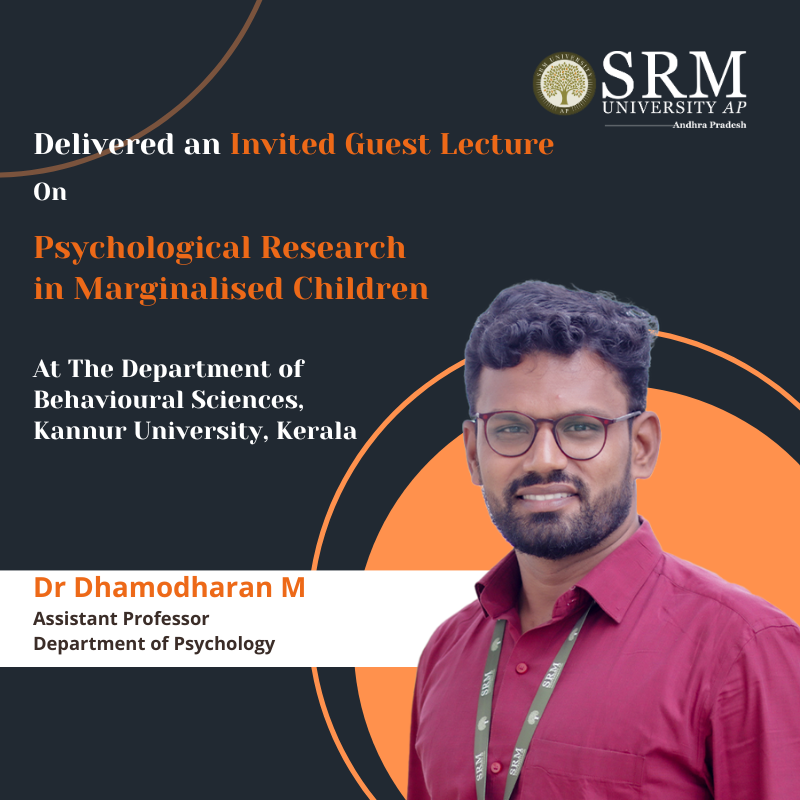
In an insightful talk at the Department of Behavioural Sciences in Kannur University, Dr Dhamodharan M, Assistant Professor at the Department of Psychology, SRM University-AP, shed light on “Psychological Research in Marginalized Children.” Dr Dhamodharan’s talk serves as a call to action, encouraging a deeper exploration of psychological research for the betterment of future generations.
Here’s an abstract of Dr Dhamodharan’s riveting talk.
Abstract
The invited lecture mainly focuses on the status and importance of psychological research in marginalized children. Marginalized People who are excluded from majority social, economic, educational, and/or cultural life. They are excluded due to race, gender identity, sexual orientation, age, physical ability, language, and/or immigration status (Baah et al.,2019). The term marginalized children include Children affected by or emerging from armed conflict or humanitarian crises, Children with disabilities, Children in remote or rural areas (including those who lack access to safe water and sanitation), Religious or ethnic minorities, Orphans, and children affected by HIV/AIDS, Child laborers, Married Children, Victims of trafficking (Legal Information Institute,2023). The World Health Organization defined “Child maltreatment is the abuse and neglect that occurs to children under 18 years of age. It includes all types of physical and emotional ill-treatment, sexual abuse, neglect, negligence, and commercial or other exploitation, which results in actual or potential harm to the child’s health, survival, development, or dignity in the context of a relationship of responsibility, trust or power” (World Health Organization, 2020). Children need essential nutrition, parental care, education, safety, entertainment, medical assistance, and physical, psychological, and social development (Deb & Ray, 2015). Children have their first human contact at home in a pleasant, nurturing, and caring environment; unfortunately, home is also where children are exposed to violence for the first time (United Nations Children’s Fund,2017). All children have the right to be safe from violence, oppression, and abuse. Despite this, globally, millions of children from all socioeconomic backgrounds, religions, cultures, and ages are subjected to violence and abuse daily. Violence against children is typical and endemic, and it is a terrible reality for millions of Indian children.
Over half of the world’s children have been subjected to extreme violence, with South Asia representing 64% of these instances (End Violence against Children | UNICEF India, n.d.) All types of violence against persons under 18 are considered violence against children. In 2019, about 1 billion children under eighteen experienced physical, sexual, or emotional violence or neglect globally (WHO, 2020). In the world, 3 out of 4 children aged 2-4 years were subjected to violent regulation from caregivers daily. Six out of ten children were exposed to physical punishment, one out of every two children aged 2 to 17 experienced some type of violence, and 18% of girl children experienced childhood sexual violence, while 8% of boys experienced the same (UNICEF, 2020; United Nations Children’s Fund, 2017). Victims of child abuse have also been exposed to more than one type of violence (Descartes et al., 2020).
Many countries are not prohibited corporal punishment. One in every two children aged 6 to 17 is subjected to corporal punishment. Around fifteen million girls aged 15 to 19 have been subjected to forced sex from partners, boyfriends, or husbands, with just one percent seeking professional help. Throughout the world, 1 in every three children aged 13 to 15 has experienced bullying at school. Girls face more psychological bullying than boys, whereas boys face more physical bullying than girls (UNICEF, 2020. Sexual assault and exploitation are the most common violence in slum regions. Those in positions of supremacy and authority, such as educators and leaders, are the primary perpetrators. Early pregnancy is also a serious concern among the underprivileged community, which leads to sexual exploitation (Nagasurendran, 2017).
Approximately 70 lakh children in India are not receiving all vaccinations, particularly in slum areas, migrant settlement areas such as fisher villages, construction sites, and inaccessible villages. This data is very high compared to all other countries globally. Proper childhood nutrition is a significant indicator of development and welfare, especially in developing countries. However, previous literature studies failed to focus on the children from the marginalized communities. The students from Psychology background need to explore the marginalized children’s health, education, and mental health. Furthermore, the marginalized children study findings would be an eye-opener for the social welfare department to take need-based welfare measures for marginalized children.
Current Status of Research
- Convenience sampling procedures overrepresent dominant groups (Rad et al., 2018)
- Only 5% of articles in one premier psychology journal predominately sampled ethnic minorities (Thalmayer et al., 2020)
- Less than 2% of psychological studies across three decades of research included sexual minorities as participants (Lee & Crawford, 2021)
Major Challenges faced by Marginalisation Children
- Health Issues – Malnutrition, Lack of healthcare facilities
- Lack of Educational Support
- Abuse and Violence
- Lack of Social Support
- Caste Discrimination
Areas to Study in Marginalization Children
- Discrimination in School and Community (Deb, 2019)
- Resilience and coping mechanisms (Dar,2020)
- Educational motivation and Teacher-student relationships (Martin,2020)
- Traumatic and Post Traumatic Stress (Szota,2023)
- Identity Formation (Yosef,2023)
- Social Support and Media Influence (Kaskazi,2023)

